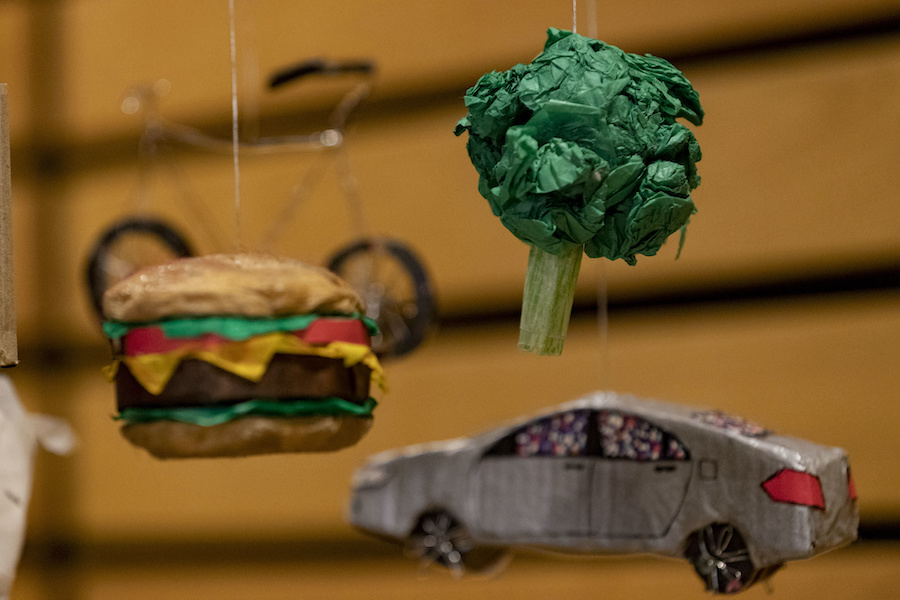eARTh Exhibition: Art for an Insistent Future
By Kyubin Kim ’22
Curators Ana Gunther ’23 and Sawyer Gouldman ’23 introduced the eclectic art show on Wednesday, December 8, congratulating the nineteen featured artists whose contributed works spanned mediums from visual arts and poetry to dance.
In their campus-wide call for submissions, Gunther and Gouldman wrote that they were “looking for art that conveys the urgency of our climate crisis and the importance of solutions.” They asked, “As the future becomes insistent, how can we direct our energy toward art, activism, and action to claim our future?”
Embracing the in-person format for the fall 2021 exhibition, the show featured three live performances.
Starting the evening with spoken-word readings, Dylan Richmond ’24 recited a poem titled “Matricide,” and K Zhan ’25 shared her poem “A Scream in Color, a Funeral in White.”
The poetry readings were followed by the first-ever dance performed on the Roux Lantern steps. Tiffany Delgado ’23, a theater and dance major (along with government and legal studies), choreographed the inaugural piece, Human Connection. In her artist’s statement, Delgado describes how people often speak in a dissociative state about climate change. She proposes instead that our treatment of the environment reflect our compassionate treatment of one another. Featuring sounds of subways and melting glaciers, the dance highlighted “the beauty, love, and joy we derive from human connection.”
Following the live performances, students dispersed around the first and second floors of the Roux Center to view the displayed art pieces and artist statements.













This was the second eARTh exhibition but the first to be held entirely in-person. In the inaugural eARTh exhibition last May, student artists responded to the relationship between humans and the environment. Due to the circumstances, the show was presented and preserved using a virtual format.
Bridget Spaeth, academic coordinator for the earth and oceanographic science department, structured the curatorial job as a student employment opportunity in service to the department's goals and values. "We have wanted to bring forward science communication and cross-disciplinary solutions and conversation about the climate," she said.
Gunther and Gouldman have been committed curators over the past year. "It feels daunting to constantly advocate for the Earth because it’s hard to make a dent in the work we need to do as a society to combat climate change," Gunther said, but "art is a powerful way to make people care."
The show, by amplifying the work of students, has been an outlet for her, she added. "It’s clear from the submissions we got that Bowdoin students are thinking deeply about climate change and expressing themselves through their artistic medium of choice," she said.
Gouldman said he was inspired by his studies in earth and oceanographic science and sculpture, "as well as the incredible artwork" he's seen by classmates. "Students at Bowdoin are all incredibly talented in their own ways, and we wanted to highlight their talents to address one of the most pressing issues of our time."










eARTh Highlights:
Let Them Eat Plastic by Thea Bell ’22 and Matsu Hikida ’22 featured a plastic sculpture of a wig and hoop skirt inspired by the French Rococo style that “sought to critique the overproduction and overconsumption of manufactured goods.”
Decalcified by Katherine Page ’23 featured an acrylic painting dotted with monochrome mollusks in response to ocean acidification and the effects of decalcification in marine organisms.
Snap Streaks by Tor Parker ’21 featured photographs of the Androscoggin river corroded by the artist’s film-processing “failures” as an imitative example of “how the chemicals and human error that tampered with these images of nature relates to the reality of climate change.”
May’s Goodbye by Ben Norwood ’25 featured poetry that criticized the failed, ineffective solutions to climate change. “Are we not become apostles of misery?” the poem begins.
“While at times the future of our planet looks grim, the artists were able to bring their own experiences and knowledge to raise awareness. The enthusiasm we saw from the artists and members of our community shows the urgency of working together for a better future.”
—Sawyer Gouldman ’23

The eARTh exhibition was proposed and supported by the Earth and Oceanographic Science Department with special thanks to Academic Department Coordinator Bridget Spaeth.
Photos by Andrew Estey.